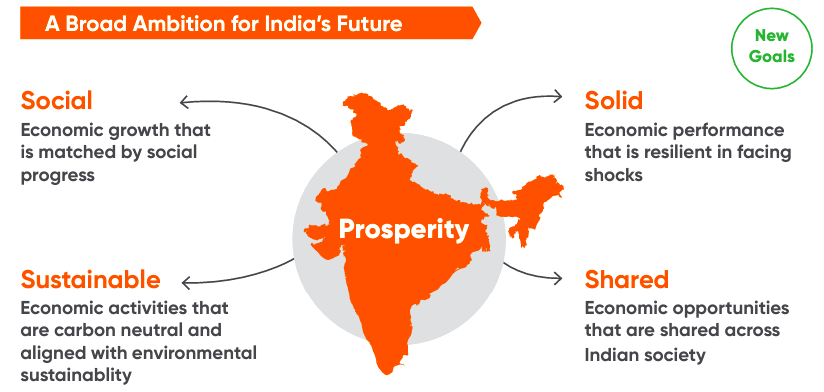Indian Economy
India to Contribute 15% of Global Growth in 2023: IMF
- 23 Feb 2023
- 7 min read
For Prelims: International Monetary Fund,Gross domestic product, Russia- Ukraine War, World Inequality Report 2022, Special economic zones.
For Mains: Factors Responsible for India's Economic Rise, Roadblocks in Achieving Sustainable Economic Growth.
Why in News?
According to the International Monetary Fund (IMF), India will alone contribute 15% of the global growth in 2023 and continues to remain a relative "bright spot" in the world economy.
Which Factors are Most Responsible for India's Economic Rise?
- Growth Prospects: India remains a bright spot at a time when the IMF is projecting 2023 to be difficult with global growth slowing down from 3.4% in 2022 to 2.9% in 2023.
- For FY 2023/24 (April 2023 to March 2024) India’s growth rate is projected at 6.1% a bit slow like the rest of the world economy, but way above the global average.
- And in that way, India is providing about 15% of global growth in 2023.
- For FY 2023/24 (April 2023 to March 2024) India’s growth rate is projected at 6.1% a bit slow like the rest of the world economy, but way above the global average.
- Digitalisation: According to the IMF, India has turned digitalisation into a driver of overcoming the pandemic and creating job opportunities, while the country's fiscal policy has been responsive to economic conditions.
- Investment in Green Economy: The country's fiscal responsibility has been translated into a medium-term framework, with a strong anchor to public finances.
- Also, India is investing in the green economy, including renewables with potential to shift the country towards clean energy.
- Capital Spending: The capital spending has increased, which would amount to 3.3% of gross domestic product, and will be the biggest such jump after an increase of more than 37% between 2020-21 and 2021-22.
- Demographic Dividend: India does have a young population. 15 million people are added to the labour force every year. Strong investment climate that generates jobs is a great advantage for India. Women can be a fabulous driver for India’s growth.
What are the Roadblocks in Achieving Sustainable Economic Growth?
- Contemporary Geopolitical Issues: Emerging markets (including India) bear the brunt of the geopolitical risk in more ways than one including supply chain constraints widening the gap between demand and supply.
- For instance, the Russia- Ukraine War has resulted in global food shortages.
- Jobless Growth in Recent Past: According to CMIE (Centre for Monitoring Indian Economy), the unemployment rate in India is around 8% (December 2022). This is because job growth has not kept pace with GDP growth.
- Only 40% of the labour force that is capable of working is actually working or looking for work, in which women have a lower participation rate.
- Widening Rich-Poor Gap: As per the 'World Inequality Report 2022', top 10% of India's population hold 57% of the total national income while the bottom 50% share has gone down to 13%.
- India's inequality is driven by limited upward mobility due to unequal opportunity.
- Widening Trade Deficit: India's export trend has declined, with India's trade deficit reaching a record 31 billion dollars in July 2022 due to recessionary trends in developed economies (like the US) and higher commodity prices.
- The capital outflows and the rising current account deficit is putting pressure on the Indian rupee.
How India can Ensure Sustainable Economic Growth?
- Setting up Economic Development Goals: India’s performance depends not only on how well it addresses the challenges of today but also in its preparedness for future challenges.
- India needs to ensure that its policy choices are robust and forward looking with modern technological solutions. For this, an effective strategy for India needs to be based on a transparent articulation of the country’s economic development goals.
- These goals should outline an ambition that is bold, energising, and reflective of the aspirations of the country.
- Manufacturing in India, for India and World: There is a need to strengthen the Make in India initiative with special emphasis on the 'zero defect zero effect'.
- There is also a need for reform in the banking sector that can help boost small-scale manufacturing instead of only large-scale.
- Unlocking the Potential of Indian Women: Closing the gender gap in education and financial and digital inclusion of women and breaking down the glass ceiling should be the priorities.
- Strengthening Special Economic Zones: More special economic zones are needed to enhance foreign investment, increase exports, and support regional development.
- Baba Kalyani Committee on SEZs has recommended that MSME investments in SEZs be promoted by linking them to MSME schemes and allowing sector-specific SEZs.
UPSC Civil Services Examination, Previous Year Question (PYQ)
Prelims
Q.1 With reference to the Indian economy after the 1991 economic liberalisation, consider the following statements: (2020)
- Worker productivity (Rs. per worker at 2004-05 prices) increased in urban areas while it decreased in rural areas.
- The percentage share of rural areas in the workforce steadily increased.
- In rural areas, the growth in the non-farm economy increased.
- The growth rate in rural employment decreased.
Which of the statements given above is/are correct?
(a) 1 and 2 only
(b) 3 and 4 only
(c) 3 only
(d) 1, 2 and 4 only
Ans: (b)
Mains
Q. Do you agree that the Indian economy has recently experienced V-shaped recovery? Give reasons in support of your answer. (2021)







